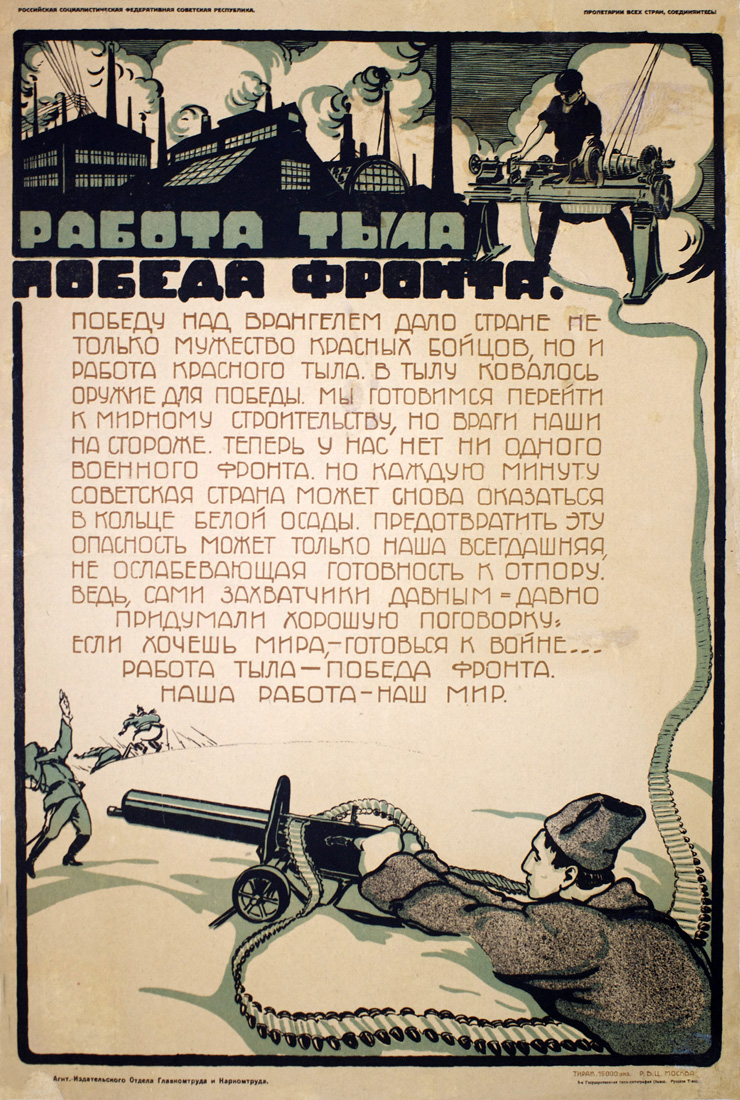
The work of the back line is the victory of the front line. "Our country won a victory over Wrangel not only by the courage of the Red soldiers but by the work of the Red back lines." [Partial translation]
Poster Number: PP 358
Category: Civil War
Poster Notes: Baron Pyotr Nikolayevich Wrangel’ (1878-1928) was a Russian officer in the Imperial Army and a commanding general of the anti-Bolshevik White Army in Southern Russia. The Red Army of the Bolsheviks defeated Wrangel’ and his forces in 1920.
Media Size: 30.5x22
Poster Type: Lithograph
Publishing Date: c. 1920
Technical Information on Poster: RVTs (Passed by Military Censor), Moscow.
Print Run: 15,000
Sources & Citation: Soviet Posters of the era of the Civil War 1918-1921 by B.S. Butnik-Siverskii (1960), page 304, poster 1609
Catalog Notes: PP 358 Civil War
Artist: Artist Unknown — неизвестный художник
The artist's name on the poster is not indicated. By assigning Artist Unknown to a poster it also could mean the artist used a chop mark whereby no signature is seen thus rendering the artist's identity anonymous.
Read More About This Artist
Printer: 5th State Typolithography Workshop, Moscow (formerly Russian Partnership) — 5-я государственный типо-литография, (бывш. Русское товарищество)
Located in the Chistye Prudy neighborhood at 14 Myl'nikov Lane (a.k.a. Zhukovskii Street); the 5th State Typolithography Workshop was the Russian Partnership prior to its nationalization. Around 1922 the printer was placed under the Mospoligraf printing trust during a period of consolidation that occurred in the Moscow printing industry. With a staff of over two thousand, Mospoligraf oversaw a myriad of printers under local sections. Subsequently, Mospoligraf was the second-largest printing trust in Moscow outside ...
Read More About This Printer
Publisher: Glavkomtrud and Narkomtrud (Main Committee on Universal Compulsory Labor and Public Commissariat of Labor) — Главкомтруда и Наркомтруда
Glavkomtrud (Main Committee on Universal Compulsory Labor) was established in 1920 during the Russian Civil War to mobilize labor troops to help win the war for the Bolsheviks and rebuild infrastructure. It was divided into provincial branches called Кomtruds (Labor Committees). Glavkomtrud and the Komtruds were both interdepartmental organizations devised for coordinating mandatory labor conscription. The People’s Commissariat for Labor (Narkomtrud) collected data concerning the number of eligible workers for conscription. Labor mobilization spanned a v...
Read More About This Publisher